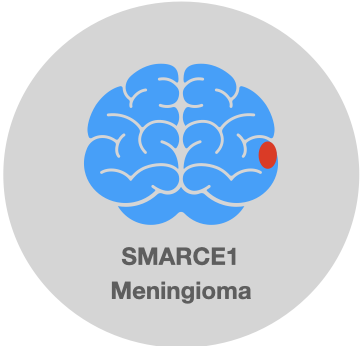Association between Pathogenic Mutations in SMARCE1 and Meningioma: Summary of Case Reports and Multi-Patient Studies.

Introduction:
Meningiomas, although relatively rare in children and adolescents, are one of the most common primary intracranial tumors in adults. Despite their prevalence, meningioma research has historically received less attention than more aggressive brain tumors. However, recent advancements have shed light on the molecular underpinnings of meningiomas, particularly the association between pathogenic mutations in the SMARCE1 gene and meningioma development.
This article aims to provide a comprehensive review and meta-analysis of the association between pathogenic mutations in SMARCE1 and meningioma. We will examine case studies and cohort-based studies that point toward a strong link between SMARCE1 pathogenic mutations and meningioma. We used evidence from the published articles identified and compiled with the help of the Nucleati Germline Cancer Evidence Base.
Tabular summary of case reports
| Patient/Family | Gene/Variation | Clinical Characteristics | HGVS(es) | Citation |
|---|---|---|---|---|
| An extended family with a pediatric patient and an adult patient suffering from CCMs, along with several asymptomatic relatives. | Heterozygous loss-of-function germline mutations in the SMARCE1 gene, identified in both symptomatic patients and asymptomatic family members. | The family has a history of clear cell meningiomas (CCMs), with two diagnosed cases (one pediatric and one adult) and several asymptomatic carriers of the SMARCE1 mutation. The complete tumor spectrum in this family is unknown. | NM_003079.5(SMARCE1):c.808del (p.Arg272fs) | Neurogenetics (2016) Pubmed |
| Young adult with spinal clear cell meningioma; mother and maternal grandfather also tested positive for SMARCE1 PVs | SMARCE1 gene with germline loss of function pathogenic variant | Family history of spinal and intracranial meningiomas; presymptomatic carriers of SMARCE1 PVs | - | American journal of medical genetics. Part A (2021) Neurogenetics (2016) Pubmed |
| Atypical meningioma patient | NF2 splice donor mutation, PIK3CA variant, SUFU variant, SMARCE1 variant, SMO variant, | Recurrent meningioma with genetic heterogeneity, persistent NF2 mutation, pathogenic PIK3CA L1006F mutation likely to be a tumor-driving mutation. | - | Clinical neuropathology (2022) Neurogenetics (2016) Pubmed |
| Mother and daughter with a SMARCE1 mutation resulting in a cervical clear cell meningioma at an identical location | SMARCE1 mutation | Clear cell (CC) meningioma, cervical spine manifestation, progressive myelopathy. | - | Journal of neurosurgery. Case lessons (2023) Neurogenetics (2016) Pubmed |
| A 16-year-old girl presenting with spinal clear-cell multiple meningiomas (CCMs). Her asymptomatic father and sister also carry the variant, with the sister having two spinal lesions. | The patient carries a heterozygous variant in the SMARCE1 gene. The somatic DNA from the CCM revealed a loss of the wild-type allele. | The patient presented with multiple spinal CCMs. Her asymptomatic sister was found to have two spinal lesions. | - | Eur J Med Genet (2023) Neurogenetics (2016) Pubmed |
Tabular summary of multi-patient studies
| Cohort | Setup | Outcome | HGVS(es) | Citation |
|---|---|---|---|---|
| NF2, schwannomatosis, meningiomatosis patients | Targeted NGS of NF2, SMARCB1, LZTR1, SMARCE1, and SUFU tumor suppressor genes | SMARCE1 variant found in 8% of meningiomatosis patients | NM_003079.5(SMARCE1):c.242G>A p.(Trp81Ter), NM_003079.5(SMARCE1):c.281G>A p.(Trp94Ter) | Neuro-oncology (2018) Pubmed |
| Individuals with familial multiple spinal meningiomas without NF2 mutations | SMARCE1: heterozygous loss-of-function mutations | Tumors were of clear-cell histological subtype, and all had loss of SMARCE1 protein | NM_003079.5(SMARCE1):c.328G>T (p.Glu110Ter), NM_003079.5(SMARCE1):c.92del (p.Tyr31fs), NM_003079.5(SMARCE1):c.808del (p.Arg272fs), NM_003079.5(SMARCE1):c.688C>T (p.Gln230Ter), NM_003079.5(SMARCE1):c.493G>T (p.Glu165Ter), NM_003079.5(SMARCE1):c.714+1G>A, NM_003079.5(SMARCE1):c.472C>T (p.Arg158Ter), NM_003079.5(SMARCE1):c.542-2A>G, NM_003079.5(SMARCE1):c.369+2_369+5del, NM_003079.5(SMARCE1):c.369+1G>T, NM_003079.5(SMARCE1):c.871C>T (p.Gln291Ter), NM_003079.5(SMARCE1):c.541+1G>A, NM_003079.5(SMARCE1):c.751C>T (p.Arg251Ter), NM_003079.5(SMARCE1):c.313C>T (p.Arg105Ter), NM_003079.5(SMARCE1):c.525del (p.Ala176fs), NM_003079.5(SMARCE1):c.624_627del (p.Ser208fs), NM_003079.5(SMARCE1):c.815_816insT (p.Arg272fs), NM_003079.5(SMARCE1):c.340G>T (p.Glu114Ter), NM_003079.5(SMARCE1):c.572dup (p.Ala192fs), NM_003079.5(SMARCE1):c.311G>A (p.Trp104Ter), NM_003079.5(SMARCE1):c.237+2T>C, NM_003079.5(SMARCE1):c.715C>T (p.Arg239Ter) | Nature genetics (2013) Pubmed |
Conclusions:
In conclusion, our review of genetic evidence in case reports and multiple patient studies highlights the evidence supporting a potential association between pathogenic mutations in SMARCE1 and meningioma. While additional research is necessary to strengthen our understanding of this relationship, these findings contribute to the growing knowledge on the genetic factors involved in meningioma development.
Additionally, we would like to emphasize the valuable contribution of AI-collected, categorized, and curated data in platforms such as the Nucleati Germline Cancer Evidence base. These platforms enable researchers to efficiently access and analyze evidence from a vast amount of published literature. The Nucleati Germline Cancer Evidence base, tailored explicitly for germline cancer research, provides information that can aid in quickly identifying relevant evidence related to SMARCE1 mutations and meningioma.
By leveraging AI technology, Nucleati streamlines the evidence collection and categorization process, saving researchers significant time and effort. The ability to access comprehensive and curated datasets dramatically facilitates the identification of crucial studies, emerging trends, and critical information about the association between SMARCE1 mutations and meningioma.